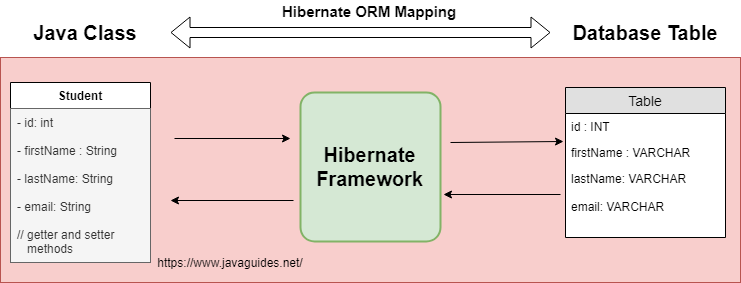📘 Premium Read: Access my best content on Medium member-only articles — deep dives into Java, Spring Boot, Microservices, backend architecture, interview preparation, career advice, and industry-standard best practices.
🎓 Top 15 Udemy Courses (80-90% Discount): My Udemy Courses - Ramesh Fadatare — All my Udemy courses are real-time and project oriented courses.
▶️ Subscribe to My YouTube Channel (176K+ subscribers): Java Guides on YouTube
▶️ For AI, ChatGPT, Web, Tech, and Generative AI, subscribe to another channel: Ramesh Fadatare on YouTube
Technologies and tools used
- Hibernate 6.1.7.Final
- IDE - Eclipse
- Maven 3.5.3
- Java 17
- MySQL - 8.0.32
Development Steps
- Create a Simple Maven Project
- Project Directory Structure
- Add jar Dependencies to pom.xml
- Creating the JPA Entity Class(Persistent class)
- Create a Hibernate configuration file - hibernate.cfg.xml
- Create a Hibernate utility class
- Create the Main class and Run an Application
1. Create a Simple Maven Project
2. Project Directory Structure
3. Maven Dependencies - The pom.xml File
<project
xmlns="http://maven.apache.org/POM/4.0.0"
xmlns:xsi="http://www.w3.org/2001/XMLSchema-instance"
xsi:schemaLocation="http://maven.apache.org/POM/4.0.0 http://maven.apache.org/xsd/maven-4.0.0.xsd">
<modelVersion>4.0.0</modelVersion>
<parent>
<groupId>net.javaguides.hibernate</groupId>
<artifactId>hibernate-tutorial</artifactId>
<version>0.0.1-SNAPSHOT</version>
</parent>
<artifactId>hibernate-merge-entity-example</artifactId>
<properties>
<project.build.sourceEncoding>UTF-8</project.build.sourceEncoding>
</properties>
<dependencies>
<!-- https://mvnrepository.com/artifact/mysql/mysql-connector-java -->
<dependency>
<groupId>mysql</groupId>
<artifactId>mysql-connector-java</artifactId>
<version>8.0.32</version>
</dependency>
<!-- https://mvnrepository.com/artifact/org.hibernate/hibernate-core -->
<dependency>
<groupId>org.hibernate</groupId>
<artifactId>hibernate-core</artifactId>
<version>6.1.7.Final</version>
</dependency>
</dependencies>
<build>
<sourceDirectory>src/main/java</sourceDirectory>
<plugins>
<plugin>
<artifactId>maven-compiler-plugin</artifactId>
<version>3.5.1</version>
<configuration>
<source>17</source>
<target>17</target>
</configuration>
</plugin>
</plugins>
</build>
</project>
4. Creating the JPA Entity Class(Persistent class)

- A no-arg constructor: It is recommended that you have a default constructor with at least package visibility so that hibernate can create the instance of the Persistent class by newInstance() method.
- Provide an identifier property: It is better to assign an attribute as id. This attribute behaves as a primary key in a database.
- Declare getter and setter methods: The Hibernate recognizes the method by getter and setter method names by default.
- Prefer non-final class: Hibernate uses the concept of proxies, that depend on the persistent class. The application programmer will not be able to use proxies for lazy association fetching.
package net.javaguides.hibernate.entity;
import jakarta.persistence.*;
@Entity
@Table(name = "student")
public class Student {
@Id
@GeneratedValue(strategy = GenerationType.IDENTITY)
@Column(name = "id")
private int id;
@Column(name = "first_name")
private String firstName;
@Column(name = "last_name")
private String lastName;
@Column(name = "email")
private String email;
public Student() {
}
public Student(String firstName, String lastName, String email) {
this.firstName = firstName;
this.lastName = lastName;
this.email = email;
}
public int getId() {
return id;
}
public void setId(int id) {
this.id = id;
}
public String getFirstName() {
return firstName;
}
public void setFirstName(String firstName) {
this.firstName = firstName;
}
public String getLastName() {
return lastName;
}
public void setLastName(String lastName) {
this.lastName = lastName;
}
public String getEmail() {
return email;
}
public void setEmail(String email) {
this.email = email;
}
@Override
public String toString() {
return "Student [id=" + id + ", firstName=" + firstName + ", lastName=" + lastName + ", email=" + email + "]";
}
}
5. Create a Hibernate configuration file - hibernate.cfg.xml
<!DOCTYPE hibernate-configuration PUBLIC
"-//Hibernate/Hibernate Configuration DTD 3.0//EN"
"http://www.hibernate.org/dtd/hibernate-configuration-3.0.dtd">
<hibernate-configuration>
<session-factory>
<!-- JDBC Database connection settings -->
<property name="connection.driver_class">com.mysql.cj.jdbc.Driver</property>
<property name="connection.url">jdbc:mysql://localhost:3306/hibernate_db?useSSL=false</property>
<property name="connection.username">root</property>
<property name="connection.password">root</property>
<!-- JDBC connection pool settings ... using built-in test pool -->
<property name="connection.pool_size">1</property>
<!-- Echo the SQL to stdout -->
<property name="show_sql">true</property>
<!-- Set the current session context -->
<property name="current_session_context_class">thread</property>
<!-- Drop and re-create the database schema on startup -->
<property name="hbm2ddl.auto">create-drop</property>
<!-- dbcp connection pool configuration -->
<property name="hibernate.dbcp.initialSize">5</property>
<property name="hibernate.dbcp.maxTotal">20</property>
<property name="hibernate.dbcp.maxIdle">10</property>
<property name="hibernate.dbcp.minIdle">5</property>
<property name="hibernate.dbcp.maxWaitMillis">-1</property>
<mapping class="net.javaguides.hibernate.entity.Student" />
</session-factory>
</hibernate-configuration>
6. Create a Hibernate Utility Class
- Build the StandardServiceRegistry
- Build the Metadata
- Use those 2 to build the SessionFactory
package net.javaguides.hibernate.util;
import org.hibernate.SessionFactory;
import org.hibernate.boot.Metadata;
import org.hibernate.boot.MetadataSources;
import org.hibernate.boot.registry.StandardServiceRegistry;
import org.hibernate.boot.registry.StandardServiceRegistryBuilder;
public class HibernateUtil {
private static StandardServiceRegistry registry;
private static SessionFactory sessionFactory;
public static SessionFactory getSessionFactory() {
if (sessionFactory == null) {
try {
// Create registry
registry = new StandardServiceRegistryBuilder().configure().build();
// Create MetadataSources
MetadataSources sources = new MetadataSources(registry);
// Create Metadata
Metadata metadata = sources.getMetadataBuilder().build();
// Create SessionFactory
sessionFactory = metadata.getSessionFactoryBuilder().build();
} catch (Exception e) {
e.printStackTrace();
if (registry != null) {
StandardServiceRegistryBuilder.destroy(registry);
}
}
}
return sessionFactory;
}
public static void shutdown() {
if (registry != null) {
StandardServiceRegistryBuilder.destroy(registry);
}
}
}
7. Create the main App class and Run an Application
package net.javaguides.hibernate;
import org.hibernate.Session;
import org.hibernate.Transaction;
import net.javaguides.hibernate.entity.Student;
import net.javaguides.hibernate.util.HibernateUtil;
public class App {
public static void main(String[] args) {
Transaction transactionOne = null;
Transaction transactionTwo = null;
Session sessionOne = HibernateUtil.getSessionFactory().openSession();
transactionOne = sessionOne.beginTransaction();
// create student object
Student student = new Student("Ramesh", "Fadatare", "rameshfadatare@javaguides.com");
// save student object
sessionOne.persist(student);
// commit transaction
transactionOne.commit();
// close first session
sessionOne.close();
// open sessionTwo
Session sessionTwo = HibernateUtil.getSessionFactory().openSession();
transactionTwo = sessionTwo.beginTransaction();
// change detached student object name
student.setFirstName("Ram");
// merge method is to update a persistent entity instance with new field values
// from a detached entity instance.
sessionTwo.merge(student);
transactionTwo.commit();
sessionTwo.close();
}
}




![[NEW] Full-Stack Java Development with Spring Boot 3 & React Build 5 Spring Boot Projects with Java: Line-by-Line Coding](https://img-c.udemycdn.com/course/750x422/5338984_4d3a_5.jpg)













Comments
Post a Comment
Leave Comment